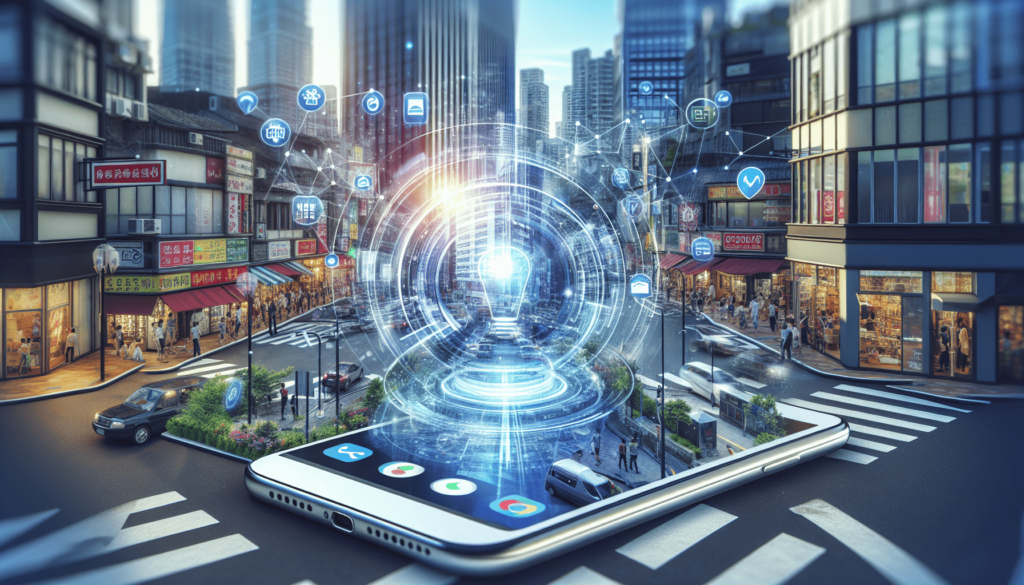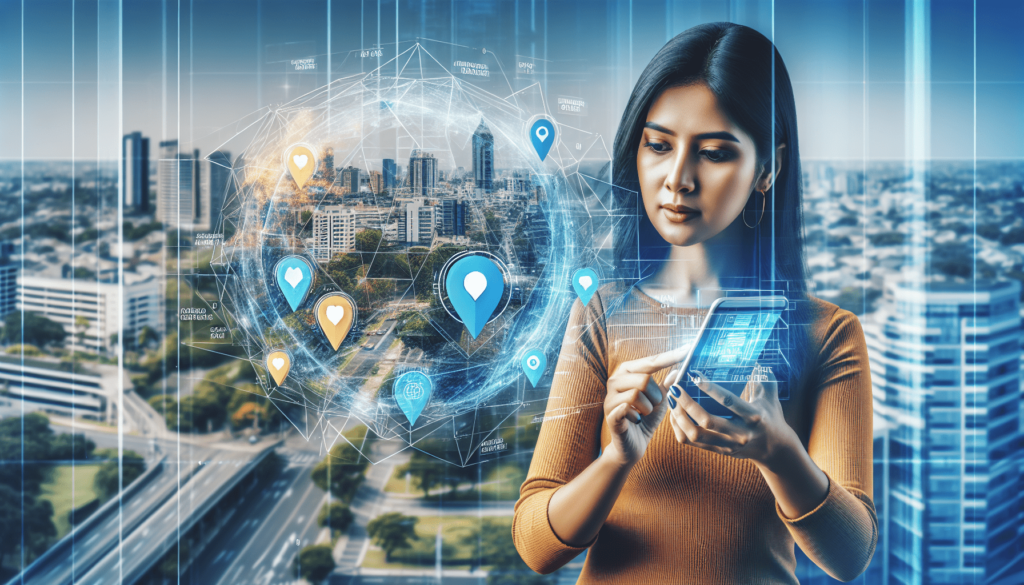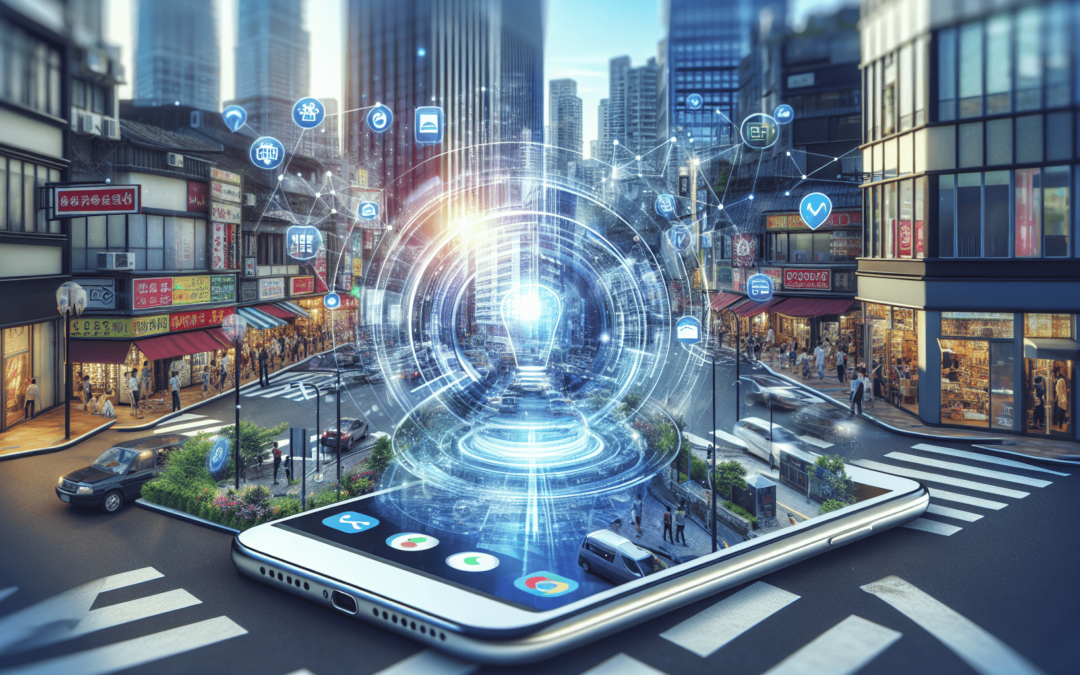Imagine being able to step into a virtual world at the click of a button or simply point your phone at a store and see all the information you need. Well, thanks to the advancements in technology, augmented reality (AR) and virtual reality (VR) have become more accessible, transforming the way we interact with our surroundings. But what does this mean for local search engine optimization (SEO) and businesses? In this article, we will explore how AR and VR are shaping the future of local SEO and how businesses can leverage these technologies to enhance their online presence and attract more customers.

Understanding AR and VR
Definition of AR and VR
Augmented Reality (AR) and Virtual Reality (VR) are revolutionary technologies that have transformed the way we perceive and interact with the digital world. AR refers to the overlaying of digital information, such as images, videos, or 3D models, onto the real world using devices like smartphones or smart glasses. On the other hand, VR creates a completely immersive and artificial environment that shuts out the physical world by using headsets or goggles.
How AR and VR work
AR relies on sensors and cameras to track real-world objects and places virtual elements in the user’s field of vision. It uses computer vision algorithms to understand the environment and accurately position digital content. VR, on the other hand, uses headsets or goggles to display a virtual world that responds to the user’s head movements, offering a lifelike and immersive experience. Both AR and VR technologies require powerful processors and graphics capabilities to deliver a seamless and realistic experience.
Applications of AR and VR
AR and VR have found applications in various industries, including gaming, entertainment, education, healthcare, and even marketing. They have the power to transport users to different locations, provide interactive learning experiences, simulate real-life scenarios, and offer unique advertising opportunities. However, their impact on local SEO is invaluable as they can greatly enhance the way businesses engage with their target audience, improve search visibility, and drive customer conversions.
Importance of Local SEO
Definition and purpose of Local SEO
Local SEO focuses on optimizing a business’s online presence to generate more visibility and traffic from local search results. It is essential for businesses with physical locations or those targeting specific geographical areas. The purpose of local SEO is to ensure that a business’s website, listings, and online content appear prominently when users search for local products or services. By leveraging local SEO strategies, businesses can effectively reach their target audience, increase foot traffic, and boost sales in their local area.
Benefits of Local SEO
Local SEO offers several benefits for businesses, especially those operating at a local level. Firstly, it helps businesses stand out in search engine results pages (SERPs) by displaying relevant local listings and maps. This increased visibility can lead to higher organic traffic and better brand exposure. Additionally, local SEO allows businesses to attract more qualified leads by targeting users who are actively looking for specific products or services in their area. Furthermore, it helps build customer trust and credibility by showcasing positive reviews and ratings from local customers.
Challenges faced in Local SEO
While local SEO can be highly effective, it does come with its own set of challenges. One of the major hurdles is the constant evolution of search engine algorithms, which can affect local search rankings. Staying up-to-date with the latest SEO trends and adapting strategies accordingly is crucial. Additionally, competing for visibility in local search results can be challenging, especially in highly saturated markets. Businesses need to employ effective optimization techniques and stay vigilant to stay ahead of competitors. Finally, managing online reviews and reputation management can be time-consuming, but it is essential for maintaining a positive brand image.
AR and VR in Local SEO
Integration of AR and VR in Local SEO
The integration of AR and VR in local SEO opens up new avenues for businesses to engage with their target audience and enhance the overall local search experience. By leveraging AR and VR technologies, businesses can provide interactive and immersive experiences that go beyond traditional text-based content and static images. For example, a local restaurant can use AR to show potential customers a virtual tour of their dining space, while a real estate agent can use VR to offer virtual property tours to potential buyers.
Enhancing local search experience with AR and VR
AR and VR have the ability to make the local search experience more interactive and engaging for users. Instead of relying solely on textual information and images, businesses can leverage AR to overlay useful information, such as opening hours, contact details, or even menu items, directly onto the user’s screen. This not only saves users the hassle of searching for such information but also makes it more convenient for them to make decisions. Similarly, VR can transport users to a virtual representation of a local business, allowing them to explore the space and get a feel for the environment before visiting physically.
Improved customer engagement and conversions
AR and VR can significantly enhance customer engagement and increase conversions for businesses. By providing immersive experiences through AR and VR, businesses can captivate their target audience’s attention and create a lasting impression. Users are more likely to engage with businesses that offer unique and interactive experiences, leading to higher brand recall and increased customer loyalty. Furthermore, the ability to visualize products or services through AR and VR can boost customer confidence and increase conversion rates, as users have a better understanding of what they are getting before making a purchase.

AR and VR in Local Listings
Using AR and VR for virtual tours
AR and VR can revolutionize the way businesses showcase their physical spaces through virtual tours. Local businesses, such as hotels, restaurants, or tourist destinations, can leverage AR to offer virtual tours that allow potential customers to explore their premises from the comfort of their homes. By providing an immersive and realistic experience through VR, businesses can persuade users to visit in person, boosting foot traffic and ultimately driving sales. Virtual tours also enable businesses to highlight unique features or amenities and differentiate themselves from competitors.
Creating immersive experiences in local listings
Local listings play a crucial role in attracting customers, and AR and VR can take these listings to the next level. By incorporating AR technology, businesses can provide interactive and dynamic content that goes beyond traditional static listings. For example, a local retail store can use AR to showcase product details, display customer reviews, or offer personalized shopping recommendations. Similarly, VR can create engaging experiences within local listings, such as virtual demonstrations or simulations that allow users to interact with a product before making a purchase.
Increased visibility and customer trust
Utilizing AR and VR in local listings can significantly improve a business’s visibility in local search results. When businesses provide unique and rich visual experiences through AR and VR, search engines are more likely to rank their listings higher, as they prioritize relevant and engaging content. Moreover, by offering immersive experiences, businesses can build customer trust and credibility. Users are more likely to choose businesses that provide transparent and interactive information, as it gives them confidence in their decision-making process.
Impact on User Behavior
Changing user expectations and preferences
The introduction of AR and VR has transformed user expectations and preferences when it comes to online experiences. Users are no longer satisfied with static content or basic information. They seek experiences that are interactive, engaging, and informative. AR and VR fulfill these expectations by delivering immersive and realistic encounters that satisfy users’ curiosity and desire for exploration. Businesses that fail to meet these changing expectations may lose potential customers to competitors who offer compelling AR and VR experiences.
Increased website traffic and dwell time
AR and VR have the potential to significantly increase website traffic and user engagement. When businesses incorporate AR and VR content on their websites, users are more likely to spend more time exploring and interacting with the content. This not only increases dwell time but also reduces bounce rates, indicating that users find the content valuable and engaging. As search engines consider these metrics in their algorithms, businesses with AR and VR content are more likely to rank higher in search results, leading to even more traffic and exposure.
Positive impact on customer reviews and ratings
AR and VR experiences can have a positive impact on customer reviews and ratings. By providing interactive and immersive experiences, businesses can create memorable encounters that evoke positive emotions in users. Users are more likely to leave positive reviews and ratings when they have had exceptional experiences. Additionally, the ability to preview products or services through AR and VR can lead to more accurate expectations, resulting in more satisfied customers and ultimately better reviews and ratings.
Boosting Local Rankings
Improved website performance and loading speeds
AR and VR content can sometimes be resource-intensive, leading to slower website loading times if not optimized properly. However, optimizing website performance and loading speeds is crucial for boosting local rankings. Search engines prioritize websites that offer a seamless and fast user experience. Therefore, businesses must ensure that their websites are optimized for quick loading speeds, efficient rendering of AR and VR content, and compatibility with different devices and browsers.
Optimizing AR and VR content for search engines
To boost local rankings, businesses need to optimize their AR and VR content for search engines. This includes providing appropriate metadata, including relevant keywords, descriptions, and alt text for images or videos. By doing so, businesses enable search engines to better understand and index the content, making it more discoverable. Additionally, businesses should ensure that AR and VR experiences are accessible to search engine bots and crawlers, allowing them to accurately analyze and evaluate the content.
Local citations and backlink opportunities
Building local citations and earning backlinks from reputable sources are essential for local SEO. AR and VR content can provide businesses with unique opportunities to earn citations and backlinks by generating interest and coverage from local media outlets, influencers, or industry experts. When businesses create compelling and innovative AR and VR experiences, they stand a higher chance of attracting attention and generating organic mentions and links. These citations and backlinks can boost search visibility and improve a business’s local rankings.
AR and VR Marketing Strategies
Creating interactive and personalized AR/VR experiences
AR and VR offer immense potential for creating interactive and personalized marketing experiences. Businesses can develop AR and VR applications or campaigns that allow users to engage with their products or services in unique and memorable ways. For example, a local clothing store can create an AR app that allows customers to virtually try on clothes before making a purchase. Personalization can be achieved by tailoring AR and VR experiences based on user preferences or customized marketing messages.
Incorporating AR and VR in social media marketing
Social media platforms provide businesses with a vast audience and the opportunity to create engaging marketing campaigns using AR and VR. Platforms like Facebook and Instagram offer AR filters and effects that businesses can leverage to enhance their social media presence. By incorporating AR and VR experiences into social media marketing, businesses can increase brand awareness, engage with their target audience, and drive traffic to their websites or physical locations.
Utilizing AR and VR for local advertising
AR and VR can transform local advertising by providing unique and attention-grabbing experiences. Businesses can leverage AR to create interactive advertisements that allow users to engage with virtual objects or characters. For example, a local amusement park could run an AR advertising campaign that allows users to virtually experience rides or attractions before visiting. By providing such experiences, businesses can capture users’ attention, increase brand recall, and drive conversions.
Tracking and Analytics
Measuring effectiveness of AR and VR campaigns
Measuring the effectiveness of AR and VR campaigns is essential to refine strategies and optimize results. Businesses can track key metrics such as user engagement, click-through rates, conversion rates, or social media shares to assess the success of their campaigns. Additionally, implementing tools like heatmaps or eye-tracking technology can provide insights into user behavior and interaction patterns within AR and VR experiences.
Tracking user interactions and conversions
Tracking user interactions and conversions within AR and VR experiences is crucial to understand user behavior and make data-driven decisions. By implementing tracking mechanisms, businesses can gather valuable data on how users interact with AR and VR content, what elements or features they find most engaging, and what actions lead to conversions. This information can help businesses refine their experiences and optimize their marketing strategies.
Analyzing data to refine local SEO strategies
Data analysis plays a pivotal role in refining local SEO strategies that incorporate AR and VR. Businesses can analyze data from AR and VR campaigns to gain insights into user preferences, search patterns, or conversion funnels. By understanding how users interact with AR and VR content throughout the customer journey, businesses can identify opportunities to optimize their local SEO strategies, improve user experiences, and drive better results.
Challenges and Limitations
High implementation costs and technical requirements
One of the major challenges businesses face when integrating AR and VR into their local SEO efforts is the high implementation costs and technical requirements. Building AR and VR experiences, developing custom applications, or investing in high-quality hardware can be expensive. However, as technology advances and becomes more accessible, the costs associated with AR and VR are likely to decrease, making it more feasible for businesses of all sizes.
Compatibility issues with various devices
Another challenge is ensuring compatibility across various devices and platforms. AR and VR experiences must be accessible and perform seamlessly on different smartphones, tablets, or headsets. Businesses need to consider compatibility issues and ensure that their AR and VR content is optimized for different devices, operating systems, and screen resolutions. This requires thorough testing and QA processes to deliver a consistent experience across a wide range of devices.
Limited awareness and adoption in local businesses
Although AR and VR technologies have gained popularity in various industries, their awareness and adoption among local businesses are still limited. Many businesses may not fully understand the benefits and potential applications of AR and VR in their local SEO efforts. Educating businesses about the advantages and showcasing successful case studies can help overcome this limitation. The more businesses understand the value of AR and VR, the more willing they will be to embrace these technologies.
The Future of AR, VR, and Local SEO
Emerging trends and advancements
The future of AR, VR, and local SEO is filled with exciting possibilities. As technology continues to evolve, we can expect more advanced AR and VR experiences with improved graphics, interactivity, and realism. Emerging trends such as augmented reality glasses, haptic feedback, or mixed reality (combining AR and VR) are expected to shape the future of these technologies. Additionally, advancements in AI and machine learning will enable more personalized and context-aware AR and VR experiences.
Potential impact on local search and consumer behavior
AR and VR have the potential to revolutionize local search and consumer behavior. Users can expect more immersive and location-based search experiences, where they can explore businesses and products in a virtual environment before making real-world decisions. Local businesses that embrace AR and VR will have a competitive advantage in capturing the attention of and engaging with their target audience. Moreover, user behavior may shift towards relying more on AR and VR experiences for researching and making purchase decisions.
Opportunities for businesses and marketers
The future of AR, VR, and local SEO presents numerous opportunities for businesses and marketers. By leveraging these technologies, businesses can differentiate themselves from competitors, increase brand awareness and engagement, and drive conversions. Marketers can collaborate with businesses to develop innovative and interactive AR and VR campaigns that captivate audiences and deliver impactful marketing messages. As adoption and awareness increase, AR and VR will become essential tools in the local SEO toolbox.
In conclusion, AR and VR have a profound impact on local SEO by enhancing the search experience, improving customer engagement and conversions, boosting local rankings, and offering unique marketing opportunities. Businesses that embrace these technologies and optimize their online presence for AR and VR are likely to reap significant benefits in terms of visibility, customer trust, and sales. As technology continues to advance and awareness increases, the future holds immense potential for AR, VR, and local SEO to shape the way businesses interact with their target audience and thrive in the digital age.


